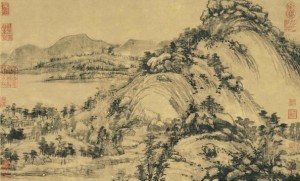 “Dwelling in the Fuchun Mountains,” a 20-foot long handscroll inked by revered Yuan Dynasty landscape painter Huang Gongwang between 1347 and 1350, has been in two pieces for over 300 years. The first and smallest section (about 20 inches wide), renamed “Broken Mountains,” currently resides in the Zhejiang Provincial Museum in Hangzhou, mainland China. The much larger second section, known as the “Master Wuyong Scroll,” is in the National Palace Museum in Taipei. Thanks to a memorandum of understanding signed in January by both museums, Zhejiang Provincial Museum will fly “Broken Mountains” to Taipei in May and both sections will reunited in an exhibit at the National Palace Museum from June 1st to September 25th.
“Dwelling in the Fuchun Mountains,” a 20-foot long handscroll inked by revered Yuan Dynasty landscape painter Huang Gongwang between 1347 and 1350, has been in two pieces for over 300 years. The first and smallest section (about 20 inches wide), renamed “Broken Mountains,” currently resides in the Zhejiang Provincial Museum in Hangzhou, mainland China. The much larger second section, known as the “Master Wuyong Scroll,” is in the National Palace Museum in Taipei. Thanks to a memorandum of understanding signed in January by both museums, Zhejiang Provincial Museum will fly “Broken Mountains” to Taipei in May and both sections will reunited in an exhibit at the National Palace Museum from June 1st to September 25th.
This idealized depiction of the Fuchun Mountains is one of Huang’s few surviving works and is considered his greatest masterpiece. It’s also one of the ten most famous paintings in Chinese history. Huang painted it at the end of his life as a gift for a fellow Taoist named Master Wuyong. A century later it was acquired by Ming Dynasty painter Shen Zhou and thus began its checkered journey. Shen Zhou sent it to a calligraphist to have it inscribed (nobody knows why since he himself was a famously accomplished calligraphist) and the calligraphist’s son stole the painting and sold it on the black market.
When it emerged on the market for sale, Shen Zhou couldn’t afford it, so he made a copy, an excellent copy, as it happened, which is highly acclaimed in its own right and is now in the Palace Museum in Beijing. Shen Zhou gave the copy to a friend, Fan Shunju, who was able to locate and purchase the original for an exorbitant price. Fan had Shen inscribe the whole story of the theft and copy on the original.
After that, the painting passed through various hands until it was bequeathed to one Wu Hongyu during the early Qing Dynasty (second half of the 17th century). Wu loved it so much he had it burned on his deathbed so it would be with him in the netherworld. Thankfully, his nephew Wu Jing’an rescued the handscroll from the flames, but it was burned in parts already and had been torn in two. That’s where the two pieces parted ways.
“Broken Mountains” belonged to a number of private collectors until painter Wu Hufan got it during the Second Sino-Japanese War (1937-1945). It went from Wu to the Zhejiang Provincial Museum where it remains today.
The “Master Wuyong Scroll” was owned by a number of court officials, eventually making its way to the Imperial Palace itself. Emperor Qianlong (reigned 1736 to 1796) was convinced it was a forgery, however. He fancied himself quite the expert and was sure that a copy he already had was the original and that the original was a copy. Since he was the emperor people agreed with him, and the error wasn’t corrected until well into the reign of his son, Emperor Jiaqing, in 1816.
After the Kuomintang lost the Chinese Civil War (1947–1949), the scroll was brought to Taiwan along with over half a million rare ancient artifacts and books from the Palace Museum and Central Museum in Beijing and Nanking.
China still claims Taiwan as part of its territory and although this has been and continues to be a source of tension, over the past three years relations have been warming thanks to Taiwanese President Ma Ying-jeou’s campaign of detente. The MOU is another step in the process. Chen Hao, director of the Zhejiang Museum, hopes that Taiwan will reciprocate and send the Master Scroll to Zhejiang so the reunited masterpiece can be displayed in mainland China as well.
Here’s the Master Scroll in all its glory (click to actually see it):